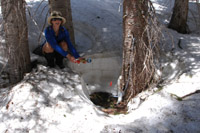- Home
- About S&T
- Taxa/Organisms
- Ecosystems
- Issues
- Methods & Tools
- Reports & Publications
- Location
- Search
Publisher: USGS | Science Center: Western Fisheries Research Center (WFRC, Seattle) | Format: URL
wfrc.usgs.gov — The whole study, conducted at Fort Benning, Georgia, partially funded through the US Army, involves testing of water and soil quality, physical and biotic indicators of stress at both the population and community level. Anthropogenic stress in the present study comes from disturbance by vehicles, particularly tanks used in army training, and from More...

Publisher: USGS | Science Center: Fort Collins Science Center (FORT, Ft. Collins) | Format: URL
www.fort.usgs.gov — Encroaching development, overuse, and air- and waterborne contaminants from outside park boundaries are causing noticeable changes to water quality and ecosystem health and functioning. The Front Range metropolitan area from Fort Collins south to Colorado Springs includes 75 percent of Colorado's population and its most productive agricultural More...

Publisher: USGS | Science Center: Columbia Environmental Research Center (CERC, Columbia) | Format: URL
www.cerc.usgs.gov — The primary goal of the proposed research is to evaluate selenium and atrazine exposure and effects to fish, amphibians, and waterfowl that utilize the Refuge. The following subordinate objectives will be met to investigate selenium exposure and effects to wildlife on the Refuge: 1.Measure selenium concentrations and total organic content in More...

Publisher: USGS | Science Center: Florida Integrated Science Center (FISC, Gainesville) | Format: URL
fl.biology.usgs.gov — Invasive nonindigenous species are important because they threaten native communities, alter habitats, and can have significant economic impacts. In aquatic environments, invasive species can be especially noxious because native species have few options for escaping direct interactions such as predation and competition for habitat and food. This More...

Publisher: NBII | Format: URL
www.nbii.gov — Natural resource managers face complex decisions that require a clear understanding of the status of wildlife populations and their habitats. Monitoring is key to making effective management decisions and evaluating the outcomes of those decisions. The goal of NRMP is to improve the accessibility of monitoring efforts to resource managers to aid More...

Publisher: USGS | Science Center: Fort Collins Science Center (FORT, Ft. Collins) | Format: URL
www.fort.usgs.gov — Natural Resource Monitoring Partnership (NRMP) is a collaborative effort by the natural resource management community to improve monitoring efforts in order to support effective evaluation and decision-making by sharing information on monitoring projects and protocols. The Natural Resource Monitoring Partnership was built for easy access to More...
